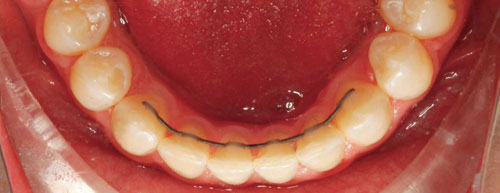CASE PRESENTATION
A Simple, Effective Approach to Bonding a Fixed Lingual Retainer After Orthodontic Treatment
A 16-year-old female presented for removal of orthodontic appliances after completion of comprehensive orthodontic treatment. Due to patient preference and previous anterior tongue thrust, fixed retention of the mandibular anterior teeth was desired to maintain final position. The patient was fully debanded, removing all fixed appliances from the teeth, cement removal was completed, and the teeth were polished.
To enhance bond strength, microetch abrasion (EtchMaster, Reliance Orthodontic Products) was used on the lingual surfaces of the mandibular incisors and canines. A pre-filled disposable reservoir tip filled with 50 μm aluminum oxide was placed into a handpiece unit and activated using the rheostat, holding the tip 1 mm from the lingual surfaces of the teeth. The nozzle of the tip was directed at the lingual surfaces in the locations where microetch abrasion was desired and used in a continuous sweeping motion over the surfaces. After completion of the microetch procedure, all surfaces were thoroughly rinsed and dried prior to initiating bonding of the lingual retainer.
After isolation of the mandibular incisors, 37% phosphoric acid etch (Reliance Gel Etchant, Reliance Orthodontic Products) was applied to the lingual surfaces of the mandibular anterior teeth. After 30 seconds, etchant was rinsed with a copious amount of water and the teeth completely air dried, leaving a frosted appearance to the enamel. Using a microbrush, 2 coats of all-surface bonding resin (Assure Plus, Reliance Orthodontic Products) were applied to the lingual surfaces of the teeth and lightly air dried, ensuring the lingual surfaces achieve a shiny appearance. Composite resin with a paste-like consistency designed for bonding lingual retainers (L.C.R., Reliance Orthodontic Products) was applied to the lingual surfaces of the anterior teeth to help stabilize wire placement.
A lingual fixed retainer wire (Retainium, Reliance Orthodontic Products) was placed into the paste-like composite and secured to the lingual surface of the anterior teeth using floss ligatures. A microbrush saturated with bonding resin was used to smooth the composite over the wire. A flowable composite resin (FlowTain, Reliance Orthodontic Products) was placed over the lingual surface of the wire and composite resin paste combination to ensure complete coverage of the fixed lingual retainer. The composite resin and retainer wire were light cured for 20 seconds per tooth, isolation and floss ligatures were removed, and any areas of excessive composite were removed with a carbide bur.

Figure 1: After removal of all orthodontic appliances, patient is ready for placement of a lingual fixed retainer.

Figure 2: Effective organization of materials allows for simple and efficient placement of a lingual fixed retainer

Figure 3: Lingual surfaces of the mandibular anterior teeth were microetched using pre-filled 50 μm aluminum oxide powder reservoir tips in a handpiece delivery unit (EtchMaster, Reliance Orthodontic Products). The tip was activated using a continuous sweeping motion 1 mm away from the tooth surface, being careful to not spray on the soft tissue.

Figure 4: Microetching creates an enhanced bonding surface for composite resin, ensuring long-term retention of the fixed lingual retainer

Figure 5: A 37% phosphoric acid etch (Reliance Gel Etchant, Reliance Orthodontic Products) was applied to the lingual surfaces of the anterior teeth corresponding to positions where the bonding resin would be placed. Enamel surfaces were etched for 30 seconds and thoroughly rinsed.

Figure 6: Two coats of all-surface bonding resin (Assure Plus, Reliance Orthodontic Products) were applied to the lingual surfaces of the teeth and lightly air dried, ensuring the lingual surfaces achieve a shiny appearance.

Figure 7: A small amount of composite resin designed for bonding lingual retainers (L.C.R., Reliance Orthodontic Products) was applied to the lingual surfaces of the anterior teeth to help stabilize wire placement.

Figure 8: A lingual fixed retainer wire (Retainium, Reliance Orthodontic Products) was placed into the paste-like composite and secured to the lingual surface of the anterior teeth using floss ligatures.

Figure 9: Flowable composite resin (FlowTain, Reliance Orthodontic Products) was placed over the lingual surface of the wire to ensure complete coverage of the fixed lingual retainer.

Figure 10: The composite resin and the retainer wire were light cured for 20 seconds per tooth.

Figure 11: Isolation and floss ligatures were removed, and any excessive composite was removed with a carbide bur.

Figure 12: Completed fixed lingual retainer.
 Dr. Shotell, DMD, is a private practice orthodontist in Sonora, CA. She has conducted research focused on the remodeling of the temporomandibular joint with the use of functional appliances utilizing cone beam imaging. Dr. Shotell has an interest in dental ergonomics and taught CE events focused on providing clinicians with simple and effective techniques as foundational principles of ergonomics to help prevent musculoskeletal disorders.
Dr. Shotell, DMD, is a private practice orthodontist in Sonora, CA. She has conducted research focused on the remodeling of the temporomandibular joint with the use of functional appliances utilizing cone beam imaging. Dr. Shotell has an interest in dental ergonomics and taught CE events focused on providing clinicians with simple and effective techniques as foundational principles of ergonomics to help prevent musculoskeletal disorders.




